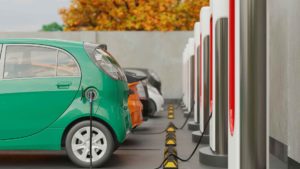
Carbon Emission and The Greenhouse Effect
Fossil fuels, including coal, natural gas, and oil, have fueled the modernization of global economies. While being the fundamental energy drivers for all developed and developing nations over the last century, they have been the biggest contributors to greenhouse emissions.
The indiscriminate use of fossil fuels has warmed up the planet. Greenhouse gases — Carbon Dioxide, Methane, Nitrous Oxide, and Fluorinated Gases — trap heat and make the planet warmer the United States Environmental Protection Agency has blamed human activities for being responsible for almost all of the increase in greenhouse gases in the atmosphere over the last 150 years.
In March 2021, National Oceanic and Atmospheric Administration (NOAA) published a report, “Climate Change: Global Temperature,” warning that although warming has not been uniform across the planet, the upward trend in the globally averaged temperature shows that more areas are warming than cooling.
According to NOAA’s 2020 Annual Climate Report, the combined land and ocean temperature has increased at an average rate of 0.13 degrees Fahrenheit (0.08 degrees Celsius) per decade since 1880; however, the average rate of increase since 1981 (0.18°C / 0.32°F) has been more than twice that rate.
The 10 warmest years on record have all occurred since 2005, and 7 of the 10 have occurred just since 2014, NOAA pointed out.
It has sounded alarm bells, too, stating that while ocean temperature doesn’t react instantly to the increased heat being trapped by greenhouse gases, by 2030, the situation will be different. The oceans’ thermal inertia will no longer matter, and unchecked carbon dioxide emissions are likely to lead to several additional degrees of warming by the end of the century.
The United States Contribution to Greenhouse Gas
The largest source of greenhouse gas emissions from human activities in the United States is the combustion of fossil fuels for electricity, heat, and transportation. Other contributors are industry, agriculture, land use, and forestry.
As per the EPA, which tracks total US emissions by publishing the Inventory of U.S. Greenhouse Gas Emissions and Sinks, electricity production is the second highest contributor to greenhouse gas emissions in the region (25 percent of 2019 greenhouse gas emissions).
Approximately 62 percent of electricity in the United States comes from burning fossil fuels, mostly coal and natural gas.
Electricity and Greenhouse Gas

While electrifying our lives for good, the electricity sector has been one of the biggest contributors to greenhouse gas emissions.
The value chain of the sector involving the generation, transmission, and distribution of electricity, has been emitting greenhouse gases like Carbon Dioxide (CO2), Methane (CH4), and Nitrous Oxide (N2O). These harmful gases are released during the combustion of the fossil fuels, such as coal, oil, and natural gas, to generate electricity.
Identifying coal as the dominant CO2 emission source related to electricity generation, the US Energy Information Administration (EIA) has noted that in 2020, the electric power sector accounted for about 38 percent of total U.S. primary energy consumption and about 32 percent of total U.S. energy-related CO2 emissions.
Source: Greenhouse Gas
In 2020, coal accounted for 54 percent and natural gas for 44 percent of electric power sector CO2 emissions. Emissions from burning petroleum fuels and non-biomass waste (mainly plastics) in waste-to-energy power plants and emissions from some types of geothermal power plants accounted for about two percent of power sector CO2 emissions, the United States Environmental Protection Agency (EIA) reported in April 2021 Monthly Energy Review.
In 2019, the EPA reported that the electricity sector was the second-largest source of U.S. greenhouse gas emissions, accounting for 25 percent of the U.S. total.
Greenhouse gas emissions from electricity have decreased by about 12 percent since 1990 due to a shift in the generation to lower- and non-emitting sources of electricity generation and an increase in end-use energy efficiency.
The EPA has identified coal as more carbon-intensive than burning natural gas or petroleum for electricity.
Against its CO2 contribution (61 percent), coal use contributed merely 24 percent of the electricity generated in the United States in 2019. Natural gas use accounted for 37 percent of electricity generation during the same period, while petroleum use accounted for less than one percent. The remaining electricity generation in 2019 came from non-fossil fuel sources, including nuclear (20 percent), and renewable energy sources (18 percent), including hydroelectricity, biomass, wind, and solar.
Mission 2050: Carbon Neutrality
Man’s damage to the Earth through the indiscriminate use of fossil fuels has been irreparable, yet scientists are not giving up, forming strategies to fix it.
The Intergovernmental Panel on Climate Change (IPCC) Special Report on Global Warming of 1.5°C has pointed out the need to achieve carbon neutrality by mid-century.
AGU Advances, which is a cross-disciplinary, open-access journal publishing research articles on Earth and space sciences, in its recent report, “Carbon-Neutral Pathways for the United States,” has said the entire US energy and the industrial system will have to be modeled with new tools to create multiple pathways to achieve net-zero and net negative CO2 emissions by 2050.
The coming 30 years will hence, be challenging for the United States as it will have to evolve practical pathways detailing the technologies, infrastructure, costs, and tradeoffs towards decarbonization.
Encouraging consumers and engaging policymakers towards decarbonization will be just the side of the coin as scientists work towards striking a fine balance between fossil fuels and using renewable sources of energy or low-carbon fuels, offering efficient and cheaper technological choices to decarbonize the Earth.
In the next decade, the actions required in all pathways would pertain to expanding renewable capacity 3.5 fold, retiring coal, maintaining existing gas generating capacity, and increasing electric vehicle and heat pump sales to more than 50% of market share, the AUG Advances report has added.
Incurring a cost of $1 per person per day, the United States may reach zero or negative CO2 emissions from the energy system by 2050 by fundamentally, systematically, and consciously increasing energy efficiency, switching to electric technologies, utilizing clean electricity (especially wind and solar power), and deploying a small amount of carbon capture technology, researchers have said.
Zero-carbon Energy Technologies
The United States has been a heavy fossil fuel-dependent economy. As it attempts to achieve Carbon Neutrality by 2050, the country has to pull up its socks over the next three decades.
From switching fuel options to inculcating behavioral changes among industrial and residential users, it has to consciously work towards eliminating or minimizing fossil fuels from its system.
Encouraging citizens to opt for public transport, walking instead of using private modes, or incentivizing industries to use clean, renewable energy sources like wind, water, biomass, geothermal or solar would go a long way to decarbonizing the economy by 2050.
The Environmental and Energy Study Institute (EESI), a non-profit organization that promotes sustainable societies, states that economies must focus on energy efficiency by eliminating energy waste.
Source: EESI
Besides reducing greenhouse gas emissions, energy efficiency reduces demand for energy imports and lowers costs on a household and economy-wide level.
While renewable energy technologies also help accomplish these objectives, improving energy efficiency is the cheapest – and often the most immediate – way to reduce the use of fossil fuels. There are enormous opportunities for efficiency improvements in every sector of the economy, whether it is buildings, transportation, industry, or energy generation, the EESI states.
- From optimizing building efficiency through renewable energy technologies, zero-energy buildings are attainable. No matter how small a step might seem, choosing LED light bulbs, for instance, would go a long way to achieve the goal of Mission 2050. Larger efforts to improve building efficiency include insulation up-gradation and weatherization.
- Using combined heat and power systems to capture the “waste” heat from power plants and use it to provide heating, cooling, and/or hot water to nearby buildings and facilities. That increases the energy efficiency of power generation from approximately 33 percent to 80 percent, the EESI has reported.
- The smart grid is another system that will improve the efficiency of electric generation, distribution, and consumption.
- Remodel neighborhood infrastructure to be conducive to safe and accessible options for walking and biking. There is also a need to push public transportation to minimize the use of fossil fuels.
- There is an urgent need to push for plug-in hybrid electric vehicles and supporting infrastructure in the respective regions to encourage the usage of energy-efficient vehicles.
- Governments must push freight corridors to minimize dependence on roads for long distances.
And then, there is the Carbon-Free Technology Initiative which is focused on implementing federal policies to ensure the commercial availability of affordable, carbon-free, 24/7 power technology options by the early 2030s to help the electric power industry meet net-zero carbon reduction commitments.
The CFTI includes the Edison Electric Institute (EEI) and its member companies, Clean Air Task Force, Bipartisan Policy Center, Center for Climate and Energy Solutions, ClearPath, Great Plains Institute, Information Technology & Innovation Foundation, Nuclear Energy Institute, Third Way.
CFTI’s recommendations at the Department of Energy (DOE) include increased funding for R&D on advanced nuclear fission technologies, carbon capture infrastructure, geothermal technologies, and zero-carbon fuels.
Tom Kuhn, president of the Edison Electric Institute (EEI), which represents all U.S. investor-owned electric companies, has said over the last five years, battery storage deployment has increased by 400 percent, solar deployment by 216 percent, and wind deployment by 59 percent. Importantly, all of this has been done while keeping rates steady and ensuring that electricity remains affordable and reliable.
EEI’s member companies are collectively on a path to reduce their carbon emissions by at least 80 percent by 2050, compared with 2005 levels, Khuh has said.
There is no one-size-fits-all solution to meet the energy needs of a country as large and as diverse as the US — weather patterns, land constraints, customer demographics, and a range of other factors mean that, in addition to addressing the technological challenges, we must address significant infrastructure and political challenges as well — he said.
EEI advocates for policies that support our clean energy transition, including getting critical transmission and energy grid infrastructure built more quickly. The transmission system is key to integrating more renewables, clean energy, and technologies into the grid affordably and reliably.
The Boron Angle
With pressures mounting on developed economies to minimize and shun fossil fuels such as coal and oil and adopt cleaner, greener, and energy-efficient fuels, the world has begun looking at boron as a potential energy source.
Boron is considered one of the energy sources of the future.
A report entitled “Potential Use of Boron for Energy Production and Storage” in Energy Sources remarked that boron and its compounds are considered “as most promising candidates to be used as hydrogen storage and production material.”
The importance of boron increases for hydrogen and fuel cell energy technologies. Hydrogen can be produced by sodium borohydride, giving no harmful by-products.
Sodium borohydride is widely used in purification chemicals, cellulose bleaching, cleaning of metal surfaces, precious metal recovery in metal surface treatment, and cleaning of heavy metals from wastewaters, apart from being a widely preferred product in electronic devices, vehicles, and electric/heat production plants, fuel cells used for military and civil purposes.
There is more. Boron’s utility has been found in nuclear plants too.
About 80% of the cost of existing nuclear plants is for the steam plant that converts about one-third of the heat to electricity and disposes of the left as waste heat to a nearby body of water. The Renewable Energy World has reported that several private companies have broken away from the military-industrial domination of government-supported energy research to develop inherently safe nuclear reactions that produce electricity and no neutrons.
Tri-Alpha is developing a device that will fire two balls of lightning (plasmoids) into each other to fuse boron and hydrogen. Boron fusion produces only safe, non-radioactive helium as a product.
Furthermore, as global scientists seek solutions to reduce energy consumption and emissions, borates have become a vital part of the effort to optimize energy efficiency and provide cleaner operations across diverse modes of transportation.
Boron is also a potential engine fuel and engine fuel additive due to its high combustion ability.
Adding borates to engine oils, fuels, and other lubricants are known to reduce engine friction, thus, increasing fuel economy and reducing harmful emissions. Borates in engine coolant (antifreeze liquid) help reduce the freezing point and increase the boiling point of those liquids.
Borate esters in fuel additives help prevent pre-ignition and keep carburetors clean. In aviation, fuel stored in tanks can absorb water, creating a breeding ground for bacterial and fungal growth. The anti-microbial properties of borates help prevent that contamination, yielding a clean-burning fuel. In addition to their corrosion-inhibitive properties, boron-containing additives have detergent and anti-rust properties and reduce knocking and sludge formation.





